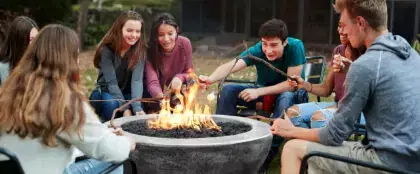Let's Make it (Email) Official
Become an AuthenTEAK Insider and be first to know about new collections, exclusive sales, and special offers.
Let's Make it (Email) Official
Become an AuthenTEAK Insider and be first to know about new collections, exclusive sales, and special offers.

Fire pits are one of the best ways to extend the use of your. If you’re considering adding a fire pit to your home—or maybe you’ve already purchased a fire pit—make sure you know the basic safety precautions. Fire pit safety is crucial to prevent burns, property damage, and other accidents.
There are three main types of fire pits: wood-burning, liquid propane, and natural gas. Each type comes with its own set of safety considerations and precautions. Wood-burning fire pits require careful attention to fuel sources, airflow, and proper extinguishing methods. Propane and natural gas fire pits, while more convenient, still pose risks if not used and maintained correctly. Regardless of the type, fire pit safety should be a top priority for any homeowner or outdoor enthusiast.

Local regulations and building codes often dictate the types of fire pits allowed and any permits required. It's crucial to check with your town or city before installing a fire pit. Common regulations include restrictions on fuel types, setback distances from structures, and requirements for screens or covers. Permits may be necessary, particularly for permanent fire pits or those exceeding a certain size. Failure to follow local codes could result in fines or having to remove the fire pit.

When using a fire pit on a deck, it's crucial to take extra precautions to ensure safety. Gas and wood-burning fire pits pose different risks, and it's essential to follow the manufacturer's instructions and local fire codes.
Gas fire pits are generally best for decks. For gas fire pits, always use the stand or base provided by the manufacturer. Never place the fire pit directly on the deck surface, as it can cause excessive heat buildup and potentially damage the decking material. Ensure proper clearance from combustible materials, typically at least 10 feet away from any structures or overhangs
Wood-burning fire pits can damage decking or potentially post safety risks, so we’d advise against placing a wood-burning fire pit on a wood deck. The intense heat can potentially warp or ignite the decking material, especially if it's made of wood or composite materials.
Regardless of the fire pit type, ensure that the decking material is heat-resistant and suitable for use with fire pits. Some composite decking materials may not be rated for high temperatures, so check with the manufacturer or local building codes for specific requirements.

Ensuring safety should be the top priority when enjoying a backyard fire pit. First and foremost, it's crucial to position the fire pit at least 10 feet away from any structures or combustible materials, as recommended by the U.S. Fire Administration. This safe distance helps prevent accidental fires from spreading.
Children and pets should always be closely supervised around fire pits. Establish clear rules and boundaries to keep them at a safe distance from the open flame. Additionally, having a readily available fire extinguisher or a garden hose nearby can help quickly douse any potential flare-ups or accidents.
Proper fire extinguishing procedures are equally important. Never leave a fire pit unattended, and ensure the fire is completely extinguished before leaving the area. Use water or sand to smother the flames and embers thoroughly, and wait until the pit has cooled down before disposing of the ashes. It’s also a good idea to keep your fire pit clean and free of debris.

When using a propane fire pit, always follow the manufacturer's instructions for proper setup, operation, and maintenance.
Before use, inspect the gas hose for cracks, holes, or leaks. Apply a soapy water solution to the hose and connections, and watch for bubbles that indicate a gas leak. If a leak is detected, do not use the fire pit until it has been repaired by a professional.
When not in use, ensure the gas supply is turned off at the tank. Store propane tanks outdoors, in an upright position, and away from sources of heat or ignition. Never store spare tanks indoors or in enclosed spaces. Regularly check the gas hose and connections for signs of wear or damage. Replace any damaged components immediately. Never attempt to repair or modify a propane tank, as this can be extremely dangerous.

Natural gas fire pits offer a convenient and relatively low-maintenance option for outdoor entertaining. Unlike propane fire pits, which require swapping out tanks, natural gas fire pits are connected directly to your home's natural gas line, providing an uninterrupted fuel supply.
One key advantage of natural gas fire pits is their built-in safety features. Many models are equipped with automatic shut-off mechanisms that detect gas leaks or other hazardous conditions, instantly cutting off the gas supply. This added layer of protection can provide peace of mind when using your fire pit.
However, the installation process for a natural gas fire pit is more involved than its propane counterpart. You'll need to have a gas line run from your home's main supply to the desired location of the fire pit, which may require professional assistance and permits, depending on your local codes and regulations. It's crucial to follow all installation guidelines and safety protocols to ensure a safe and code-compliant setup.
While natural gas fire pits may have a slightly higher upfront cost due to the required gas line installation, they can be more cost-effective in the long run, as natural gas is typically less expensive than propane, especially when purchased from a utility company.
Proper maintenance is also essential for the safe operation of your natural gas fire pit. Regularly inspect the gas lines, connections, and burner components for any signs of damage or leaks, and keep the area around the fire pit clear of combustible materials.

When using a wood-burning fire pit, it's crucial to take precautions to prevent sparks from igniting nearby combustible materials. Install a metal screen or spark arrester cover over the pit to contain any stray embers or sparks. Avoid using the fire pit on windy days, as the wind can carry sparks and ignite fires in the surrounding area.
Ensure you properly extinguish the fire when finished by dousing it with water or covering it with sand or dirt. Never leave a fire unattended. Once the fire is completely out and the ashes have cooled, dispose of them in a metal container away from any combustible materials. Following these simple precautions can help you enjoy your wood-burning fire pit safely.
Categories
Recent Posts